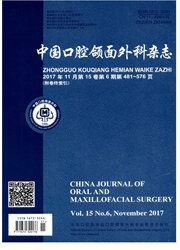

 中文摘要:
中文摘要:
目的:介绍颞下颌关节(temporomandibular joint,TMJ)镜下盘复位固定术的磁共振(magnetic resonanceimaging,MRI)和临床评价的初步效果。方法:选取门诊就诊的TMJ疾病患者进行临床检查,在初步诊断为结构紊乱(internal derangement,ID)后进行MRI检查,以获取评价关节盘情况的影像学依据,并按照Wilkes-Bronstein分期标准进行分期,将处于Ⅱ~Ⅴ期的患者纳入治疗范围,进行关节镜下盘复位固定手术。术后对接受关节镜下盘复位固定术的911例患者(1103侧关节)再次进行MRI检查,根据MRI评价标准,评价关节盘复位的效果。对复位"差"者再次进行手术,或改为开放性锚固术。结果:MRI评价显示,1032侧关节达到良以上,有效率达93.56%(1032/1103);仅有71侧、6.44%(71/1103)的关节进行了二次关节镜手术或开放性手术。临床评价的平均随访期为15.3个月(2~29个月),结果为优者32.88%(48/146),良者57.53%(84/146),差者9.59%(14/146);总有效率为90.41%(132/146)。92.47%(135/146)的患者自主感觉较术前明显改善。有效组开口度改善(14.34±5.87)mm(P〈0.001)。VAS术前29.76±23.35(0~80),术后3.71±7.91(0~50)(P〈0.05)。失败组开口度改善不明显(P〉0.05)。VAS术前3.33±5.77,术后36.67±30.55(P〈0.01)。对MRI评价与临床评价2种方法进行χ2检验,两者之间无显著性差异。结论:TMJ内镜下盘复位固定术是一种能将关节盘复位的、有效的微创术式,但其长期稳定性尚需进一步评价。
 英文摘要:
英文摘要:
PURPOSE: To evaluate the effect of arthroscopic disc suturing for treating internal derangement of the temporomandibular joint(TMJ).METHODS:Arthroscopic disc repositioning and suturing surgery was performed on patients who visited the TMJ clinic at the Ninth People's Hospital,Shanghai JiaoTong University School of Medicine,between May 2001 and May 2006 with stages Ⅱ-Ⅴ TMJ ID.The patients' ID stages were based on the criteria of Wilkes Bronstein's classification.Consecutive MRIs were used to evaluate ID before operation and after operation for all 911 patients(1103 joints).The disc position was judged according to our success criteria which included three different sagittal planes(lateral,central and medial).Arthroscopic surgery or open surgery was carried out once more for the joints evaluated as poor.RESULTS:Postoperative consecutive MRIs for all 1103 joints confirmed that 93.56%(1032/1103) joints were excellent or good,and only 6.44%(71/1103)were poor.The average follow-up period for clinical evaluation was 15.3 months(2 to 29 months),32.88%(48/146) was excellent,57.53%(84/146) was good,9.59%(14/146) was poor,the total effective rate was 90.41%(132/146).92.47%(135/146) of the patients feels more comfortable after the operation.The effective group had an improvement in mouth opening of(14.34±5.87)mm(P0.001).The preoperative VAS value was 29.76±23.35(0-80),while it decreased to 3.71±7.91(0-50) postoperatively(P0.05).The non-effective group had no significant improvement in mouth opening(P0.05).The preoperative VAS value of this group was 3.33±5.77 and 36.67±30.55 postoperatively(P0.01).There was no significant difference between MRI and clinical evaluation(P0.05).CONCLUSION: TMJ arthroscopic suturing technique is an effective,minimally invasive surgery in repositioning the TMJ disc,but long-term follow-up is necessary for the evaluation of its stability.
 同期刊论文项目
同期刊论文项目
 同项目期刊论文
同项目期刊论文
 Complete resection and immediate reconstruction with costochondral graft for recurrent aneurysmal bo
Complete resection and immediate reconstruction with costochondral graft for recurrent aneurysmal bo 期刊信息
期刊信息
